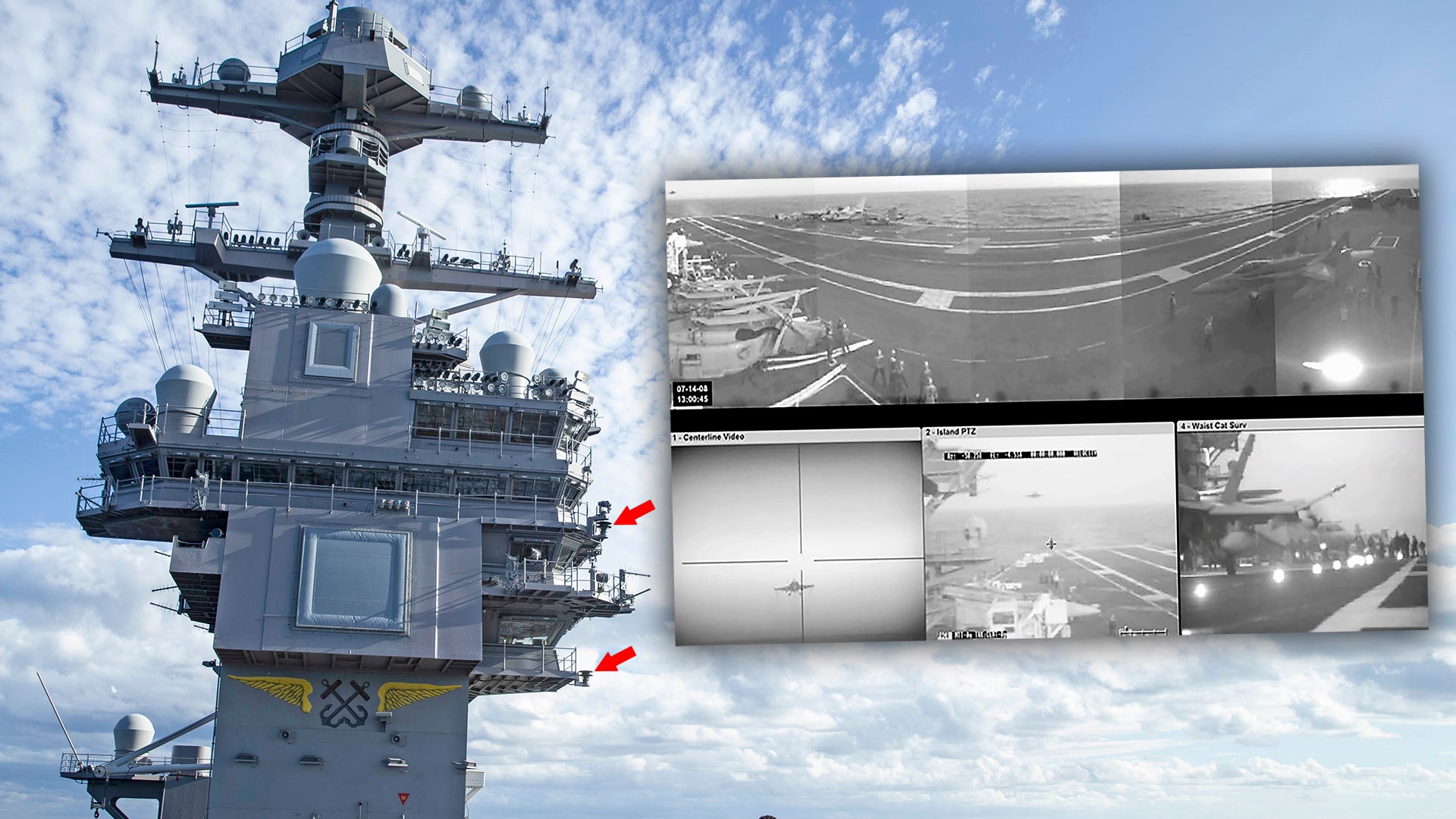In a follow-up to our recent profile on the unique wrap-around windowed enclosure, known as the Island Camera Room, found on American aircraft carriers, we have confirmation that the new Ford Class supercarriers feature a far more technologically advanced system—one that requires no windows or even a camera operator at all.
The old system, which evolved over many decades, had a camera operator inside the windowed room that filmed all the launches and recovered aboard the ship. The camera was connected to a closed-circuit video network system and much like a television studio camera, it could only look in one direction at a time. Although the technology largely stayed the same from the early 1980s on, its video products, along with other fixed cameras around the ship’s deck, were fed into ever more advanced central interfaces that dispersed the feeds to television monitors throughout the ship. This total system was dubbed the Integrated Launch and Recovery Television Surveillance (ILARTS) system.
The Ford class supercarrier, with its smaller island superstructure, has totally eliminated the Island Camera Room and has replaced it with a distributed aperture remote video system. Called Digital ILARTS, this system does what the old manned camera couldn’t, it stares in every direction at all times.
A 2019 budget document discusses the need for the new system, stating:
The Integrated Launch and Recovery Television Surveillance System (ILARTS) is based on both functional and technical obsolete 1980’s technology that is no longer supportable by industry, therefore requiring replacement and qualification of a Digital ILARTS System to meet both operational and safety requirements for Aircraft Carrier aviation operations.

The island-mounted cameras on Digital ILARTS system are housed in a pair of enclosures that look a lot like an outside propane heater or street light. Beyond being able to see everywhere at once, day or night, the Digital ILARTS is far more advanced than its predecessor. Materials from the Navy’s Aircraft Launch And Recovery Equipment Office offer a look at the system itself and an idea of what it actually sees and how it sees it. It reads:
The Integrated Launch and Recovery Television Surveillance (ILARTS) system is essential to supporting the mission of the aircraft carrier, allowing for constant monitoring of operations on the flight deck. Via monitors, personnel in the ready rooms, flight deck control and combat information center spaces are able to view recoveries, launches, and aircraft movements, enabling a rapid response in emergencies as well as a recorded archive that can be used to investigate a mishap or debrief pilots.
With the first Ford-class ship, the future USS Gerald R. Ford (CVN 78), relocation of her island and elimination of the island camera booth prompted the ALRE Team to develop a new approach for meeting requirements. Team Lead Joe Delorenzo and CVN-78 ILARTS System Engineer Ralph Smith led the effort, working with the Small Business Innovation Research program and a contractor. The team redesigned the console to fit within the condensed space and developed and implemented new cameras that can be controlled remotely from the ILARTS control room one level below the flight deck.
A special panoramic camera, comprised of eight individual views, stitches those images together seamlessly to provide a real-time view of the entire flight deck, day or night. Other elements of the ILARTS system, including the high-speed, pan-tilt-zoom camera and software in the control room, give the controller the capability of digital zoom, allowing them to zero in on a specific spot on the flight deck, such as a hook point during an arrestment, or whatever activity the console operators and deck handlers want to get a closer look at.
Smith and Delorenzo explained that by going to this new design utilizing an integrated camera system, overall situational awareness on the flight deck and surrounding air space is significantly improved, and much of the manual work required of Sailors is eliminated. The Nimitz-class configuration, with a Sailor manning the island camera booth, means that a spotter is often needed to keep an eye on everything else if the controller is focused primarily on, say, a launch on one side of the ship. On the Ford-class carrier, the full flight deck is continually in view via monitors requiring less need to manually track down aircraft on the deck.
The new ILARTS equipment has been installed and the team anticipates system turnover to the Carrier and Field Service Unit (CAFSU) representatives aboard CVN-78, as well as additional work to verify the system’s technical manual this summer. ILARTS is one of many ALRE systems critical to carrier operations that will be vetted during Flight Deck Certification, but there is always an eye toward further innovation.
“Our engineers are perpetually looking into the newest camera technologies, always looking to improve the equipment and enable the Sailor to do their jobs safely and efficiently,” said Delorenzo. “When it comes to ILARTS – with better cameras comes better vision,” he said.


If everything works as advertised, this will be a massive upgrade over the old system and will be a huge boon for anyone looking to monitor, dissect, or review deck operations. It also goes with a growing trend of putting distributed aperture camera systems aboard seagoing vessels to drastically enhance situational awareness and tactical effectiveness.
Although Ford’s
catapults, arresting gear, radar, powerplant, and munitions elevators get all the attention—for better or worse—the new supercarrier is also a packing a technological revolution of the video kind. It will be interesting seeing some products of this new system as the troubled carrier slowly teethes its way toward and operational state.
Contact the author: Tyler@thedrive.com
